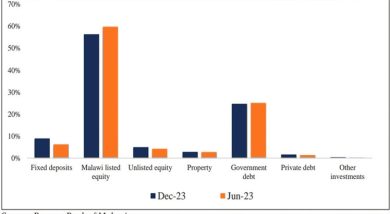Burley tobacco auction, contract price trends
Tobacco is a strategic crop in Malawi, its price discovery and pricing mechanisms have attained a very pivotal role in the country. Tobacco contributes 60 to 70 percent of all the country’s foreign exchange earnings. It provides about 45 percent of gainful employment; 25 percent of the tax base and 13 percent of the gross domestic product.
Based on the foregoing, tobacco pricing influences not only the growers return and economic state of the country, but also extends to policy and political horizons.
There have been many reforms and changes in the industry that have impacted on the structure, conduct and performance of the tobacco industry in Malawi. However, the most recent and most radical in its impact on the traditional system of production has been the introduction and establishment of integrated production system (IPS) also known as contract production and marketing.
This analysis, therefore, endeavours to analyse the impact on profitability as reflected in the price discovery process. We assess the price trends in auction and contract tobacco with regards to cost of production and minimum prices.
Auction price is the average price of all the tobacco sold at the floors in an open and unfettered competitive auction system. This is the process that has been prevalent in Malawi for many years.
Price trends
The contract price is the listed price per grade agreed in the contract between buyers and farmers. Cost of production encompasses all costs in producing tobacco including variable, fixed, marketing and management costs. It also includes interest and insurance charges. The minimum price is a reserve price set by government calculated on the basis of the agreed cost of production plus 15 percent.
In 2010, auction prices were higher than contract prices by $0.21. Auction price was $0.50 higher than the cost of production and $0.09 lower than the minimum price. Contract price was higher than cost of production by $0.29 and lower than the minimum price by $0.30.
Minimum price was set at $0.59 more than the cost of production, representing a 29 percent profit margin. The volumes under the auction system were 79 percent of the national volume and contract volumes represented 21 percent.

In 2011, auction prices were higher than contract prices by $0.03. Both were lower than cost of production and minimum pricing. Auction price was a cent lower than cost of production and $0.65 lower than the minimum price.
Contract price was $0.04 lower than the cost of production and $0.68 lower than the minimum price. The minimum price was set at $0.64 above the cost of production, representing 36 percent profit margin. Volumes under the auction system were 69 percent of the national volume and contract volumes were 31 percent.
The 2012 auction prices were a cent higher than contract prices. Both were higher than the cost of production and minimum price. Auction price was $0.82 higher than cost of production and $0.23 higher than minimum price.
Contract price was $0.81 higher that cost of production and $0.22 higher than minimum price. The minimum price was set at $0.59 above the cost of production representing 32 percent profit margin. The volumes under auction system were 55 percent of the national volume and contract volumes were 45 percent.
While 2013 saw contract price surpass auction price by $0.10. Just as in the preceding year, the two prices were higher than both the cost of production and minimum price. Auction price was $0.54 higher than cost of production and $0.26 more than the minimum price.
Contract price was higher than cost of production by $0.64 and higher than the minimum price by $0.36. The minimum price was set at $0.28 above the cost of production hence a 17 percent profit margin. Volumes under the auction system were 31 percent of the national volume and contract volumes were 69 percent.
In 2014, contract price was again higher than auction price, this time by $0.07. The prices were both higher than cost of production. Auction price was higher than cost of production by $0.51 and lower than minimum price by $0.04.
Contract price was higher than the minimum price by $0.03 and higher than the cost of production by $0.58. Minimum price was set at $0.55 above the cost of production representing a 31 percent profit margin. The volumes under auction system were 24 percent of the national volume and contract volumes were 76 percent.
Assessment
Analysis of the variables under assessment indicate a shift of price regimes between auction and contract. In the first three years auction prices were higher than contract prices by $0.21, $0.02 and $0.01. In 2013 and 2014, contract prices were higher than auction prices by $0.10 and $0.07 respectively.
Since the contract farming and marketing system was approved by government, the volumes of burley under contract farming have been increasing. Burley volumes under contract farming tripled from 39 728 274 kilogrammes (kg) in 2010 to 121 851 494 kg in 2014 representing 21 percent of the national volume in 2010 to 76 percent in 2014.
There has been a decrease in the auction volumes from 79 percent in 2010 of the national volume to 24 percent in 2014. However, 2012 is a special case and will be duly discussed.
Factors influencing prices
There are many factors that influence the prices offered for both auction and contract tobacco. Traditionally and as expected, tobacco prices offered are determined by demand and supply situation.
Production has often responded to prices offered in the previous season, with increased production following a season with good prices and declined volumes following a season with poor prices.
With a supply of 193.2 million kg national volume in 2010, prices were at $1.94 and $1.73 for auction and contract respectively. The following year, 2011, national volumes increased to 208.3 million kg leading to low prices of $1.15 for auction and $1.12 for contract.
As a result of low prices in 2011, there was low supply in 2012 of 64.6 million kg national volume. This triggered increase of prices to $2.05 and $2.04 for auction and contract respectively.
These high prices effected increase in national volumes in the following year, 2013, to 144.7 million kg. Prices were at $1.95 and $2.05 for auction and contract respectively owing to supply levels that matched demand.
In 2014, supply increased to 159.3 million kg, which was higher than the market demand leading to slightly lower prices of $1.72 for auction and $1.79 for contract than the previous year.
In conclusion, level of national volumes (supply) and share of contract volumes seem in this analysis to be key determinants in attainment of higher prices for both contract and auction sales.







